
What Is the Hybrid Cloud?
For companies that deal with sensitive information on a daily basis, having a reliable data and workflow management system is essential. In the past, many companies relied on independent or on-premises data centers to keep their information safe. But this approach could still leave companies vulnerable to risks like outside attacks, security breaches, outages and mechanical failures. If the management team wasn’t equipped to handle a situation, it could result in downtime and data loss.
Fortunately, due to the dynamic, ever-evolving nature of technology, companies can now rely on cloud-based systems. Enterprises are turning to the hybrid cloud, combining data centers with outside cloud hosting services. Companies who choose to implement hybrid cloud services will benefit from increased security, mitigated risks and improved management tools. This guide will explain the characteristics of the hybrid cloud, how it works and why it’s advantageous to employ it.
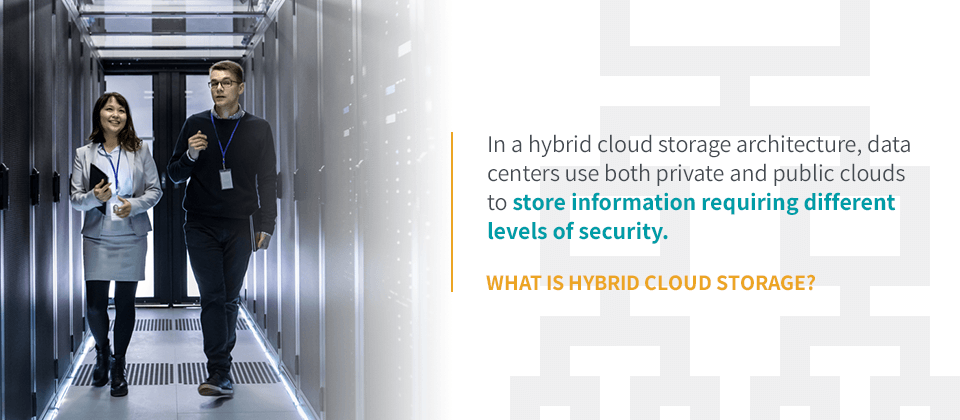
What Is Hybrid Cloud Storage?
In a hybrid cloud storage architecture, data centers use both private and public clouds to store information requiring different levels of security. It helps business owners manage their data through two channels, combining two varieties of storage to maximize the benefits of each. It’s easier to understand when you know the applications, capabilities and limitations of private and public clouds.
Private Cloud
Private cloud models consist of a company’s on-premises infrastructure and resources. The organization owns, manages and maintains all of the equipment and sets the necessary policies and processes. The cons of creating a security center solely based on the private cloud model include high initial capital expenses, the need to hire a professional IT maintenance manager, a long deployment period and a time-consuming process to scale upwards.
On a positive note, implementing a private cloud system provides you with total control over every element of your information center. You can manage the data storage units and the surrounding environment entirely, allowing you to create better security measures for highly sensitive data. It also makes it easier to comply with industry or government regulations pertaining to your data security.
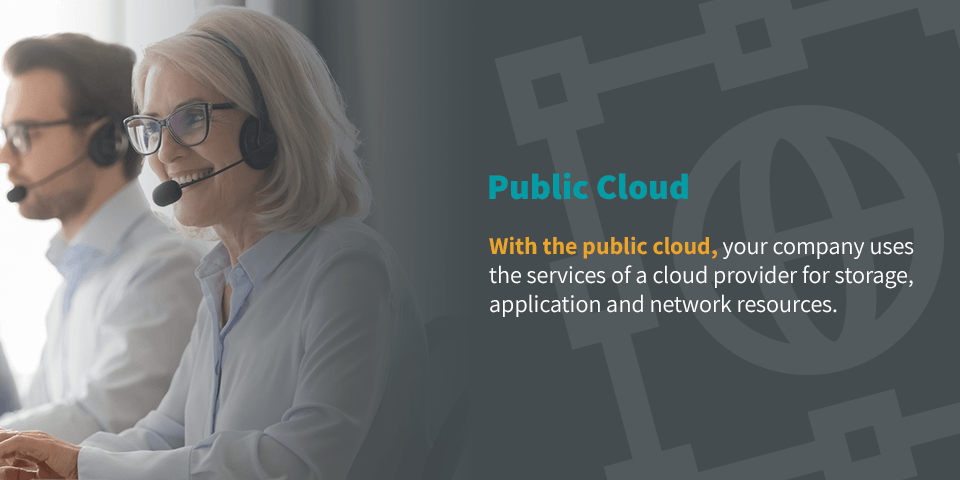
Public Cloud
Public cloud models are much the opposite but also have pros and cons, depending on the business you’re running. With the public cloud, your company uses the services of a cloud provider for storage, application and network resources. The provider owns and manages the platform, maintains the infrastructure and allows companies to purchase storage space.
On the downside, you are giving up the opportunity to have complete control over your data management. Your center is dependent on the infrastructure, performance and security of the provider. On the positive side, you only pay for the space you need for as long as you need it, as the provider bases cost on usage. Additionally, you can scale up and down simply by requesting more or less storage space, which allows your IT department to put their energy towards other projects.
Hybrid Cloud
A hybrid cloud model combines the advantages of both the private and public storage options. It merges both models to provide a more comprehensive solution. Using one of each type counts as a hybrid, but you can also expand to use multiple clouds as well. The hybrid model is highly customizable to suit your specific needs, making it an excellent choice for any business with a need for a reliable data center setup.
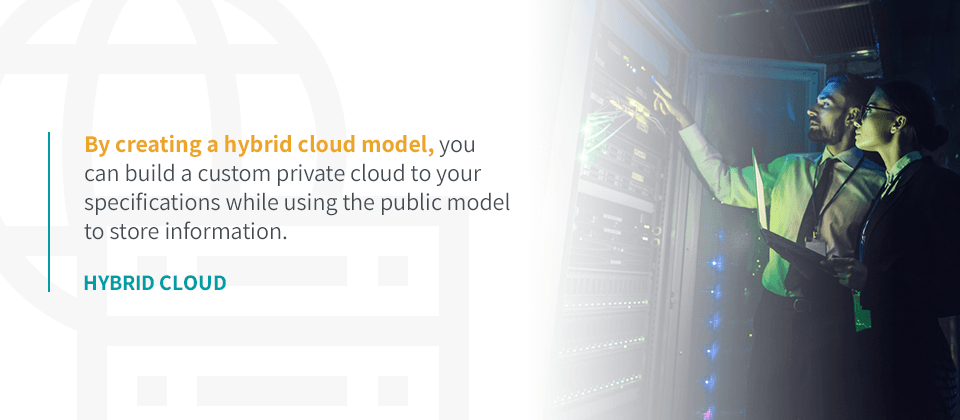
One of the best parts of using a hybrid cloud model is that you get the advantages of both individual cloud types. In addition to increasing the number of benefits, it also cancels out some of the negative aspects of using only one model. For example, by only using the public cloud, you sacrifice the opportunity to customize your security. But by creating a hybrid cloud model, you can build a custom private cloud to your specifications while using the public model to store information.
With multiple clouds, you can also create a tiered security system. One of the advantages of the private model is that it provides a higher level of security, considering your company owns and operates it individually. If you divide your data, store the most sensitive information in a private cloud and store the non-sensitive in a public cloud, you can optimize storage space while providing excellent security.
Due to its flexibility and the options it provides, hybrid cloud storage is continuing to grow in popularity. It represents the trends towards agile, simplistic and cost-effective solutions, which drive a business’s ability to be more agile and adaptable. By 2020, it is estimated that cloud services will account for 83% of company workloads, meaning a majority of enterprises are moving away from the private data-center model.
Hybrid Cloud Storage Architecture
We’ve established that a hybrid cloud is made of a combination of public and private cloud services, which is the foundation of your system’s architecture. But there are several different subsections available, including the hybrid data cloud, hybrid computing cloud, hybrid monocloud and hybrid multicloud. Both data storage and computing are part of the public cloud, and they allow your company to store information and run applications, respectively.
Depending on whether you’re new to the adoption of cloud services or if you’ve already begun integrating it into your data center, you may go about adopting the new platform in one of two ways. According to Gartner, there are two primary types of hybrid cloud infrastructure — monocloud and multicloud.
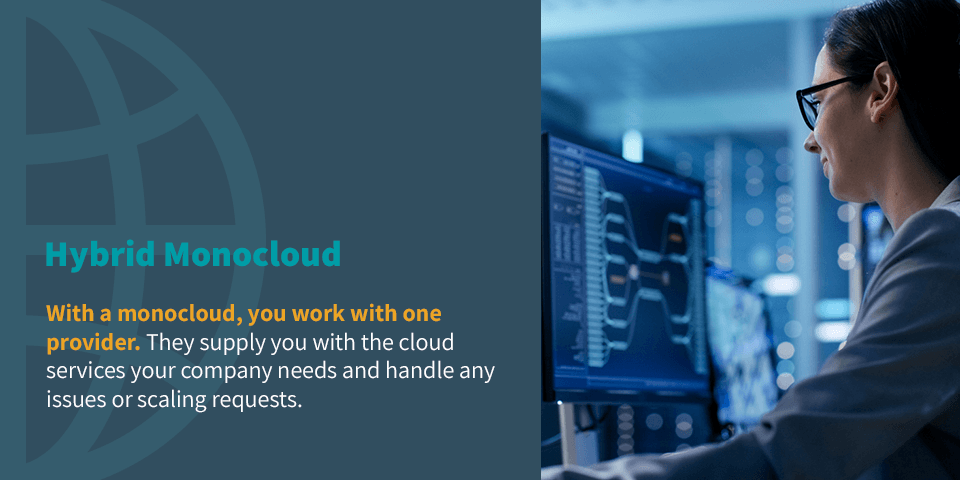
Hybrid Monocloud
If you’re just beginning to introduce cloud services into your company’s data center architecture, it may be best to apply a monocloud platform. With a monocloud, you work with one provider. They supply you with the cloud services your company needs and handle any issues or scaling requests.
It’s important to remember that you can always scale up once you’re settled, and it may be easier to start small and expand once you’ve got the hang of the management differences. It’s better to ease into the cloud systems if you’re unfamiliar, as going straight for a hybrid multicloud setup can be daunting.
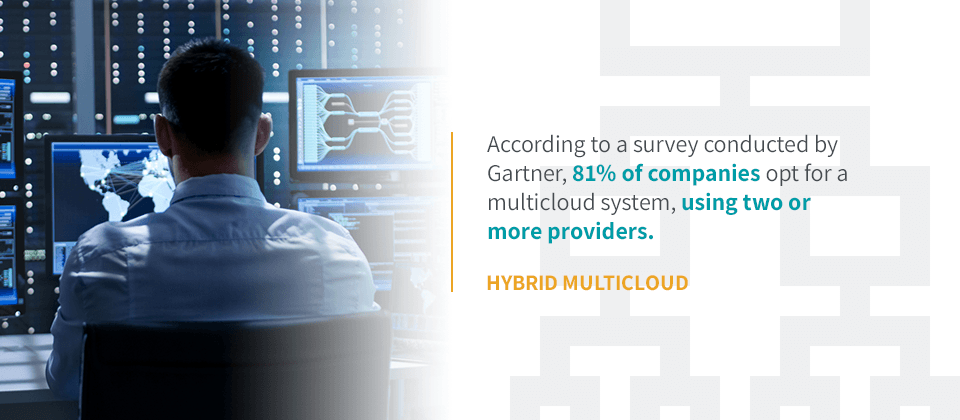
Hybrid Multicloud
If you’re more comfortable with managing cloud systems and have prior experience with the platforms, you can choose to go straight to a multicloud setup. The most significant difference is that the cloud platform spans across multiple providers while remaining part of a single architecture. According to a survey conducted by Gartner, 81% of companies opt for a multicloud system, using two or more providers.
There are several benefits to adopting a multicloud approach. For one, it can help your company avoid vendor lock-in, which you could potentially experience with the monocloud system. Vendor lock-in is a problem in which customers are tethered into working with a single vendor and aren’t able to switch without monetary and technical issues. Multicloud strategy encourages the opposite, allowing you to work with multiple providers at once.
It also helps to mitigate risks. If one provider experiences difficulties, such as an outage or failure, you’ll have several disaster recovery options at your disposal. It also decreases the effects of attacks and minimizes any form of downtime. By reducing the potential for damages due to a single failure, you can provide your customers with increased confidence that their data is safe.
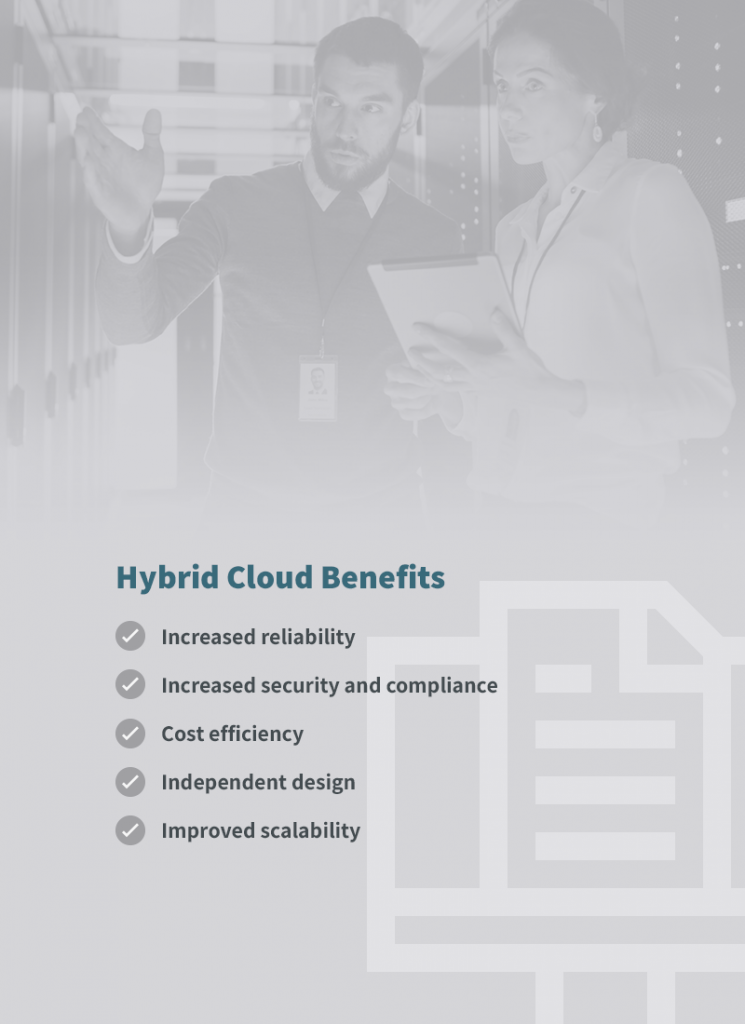
Hybrid Cloud Benefits
Cloud-based services are gaining traction. As more and more companies opt for the hybrid cloud system over their private data centers alone, the advantages are becoming more apparent. From offsite hosting to the ability to divide reliance across multiple providers, the hybrid cloud is an excellent way to keep your sensitive data secure while maintaining the processing power to handle all of your workloads.
Some of the most significant benefits of using hybrid cloud services include:
- Increased reliability: When you process data and computing from an on-premises data center, reliability is of the utmost importance. A single failure could cause your systems and workflow to break down, potentially leading to data loss, downtime or worse. Even more dramatically, severe weather or a power outage could require your team to resort to emergency generators or face downtime, both of which can be costly. By implementing the hybrid cloud, you’ll have the benefit of increased reliability. The cloud systems distribute services across multiple data centers, meaning you don’t have to rely on the success of a single facility. If one experiences a problem, your provider can shift your services seamlessly, minimizing downtime and keeping your team moving.
- Increased security and compliance: The hybrid cloud system allows your management team to divide data and workloads between public and private clouds. This distinction is important, as it means you can isolate volatile data in the private cloud and protect it with higher security measures. Meanwhile, you can keep computing and general workloads on the public cloud, as it requires less protection and allows you to focus on the sensitive information without distraction.
- Cost efficiency: Expanding and managing your on-premises infrastructure can be costly, especially with the acquisition and integration of new equipment. When you choose to work with the hybrid cloud, you’ll see lower costs. You don’t need to purchase new equipment to use the cloud services, and if you need more storage or computing power, it’s as simple as asking your provider for more space.
- Independent design: When it comes to creating a secure way to store data and process applications, choosing a hybrid cloud system provides you with the freedom to create a design that works best for your company. On-premises equipment can restrict your abilities, requiring you to purchase new items to expand or limiting you due to your budget. With a hybrid cloud system, you have more freedom to create a customized system from the start. Your company can choose the infrastructure that best suits its needs using public and private clouds and continue to scale or add new providers.
- Improved scalability: While purchasing new equipment for on-premises data centers may seem like a wise investment, it can be a hindrance. Your company’s workload is bound to fluctuate over time, and if you aren’t prepared to scale up or down quickly, it can cause problems for your management teams. With equipment, there’s no way to temporarily shift for an increased workload. However, hybrid cloud services allow your team to fluctuate with changing workloads. Your provider can help you scale immediately, increasing your computing and storage space temporarily and reducing it once the need subsides.
While the significance of the advantages depends on your company and why you choose the hybrid cloud, you will have an improved system as compared to relying on a private data center. Beyond security and workflow management, the cloud allows your company far more freedom and the ability to make changes to your infrastructure quickly and seamlessly.
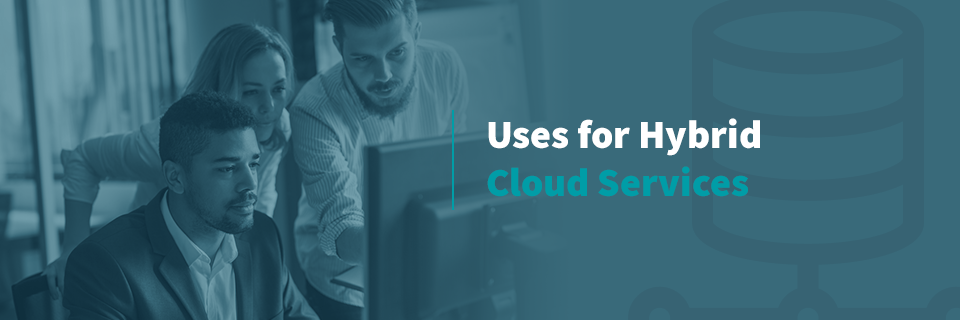
Uses for Hybrid Cloud Services
Instituting a hybrid cloud data management system is more than just a safeguard for security purposes. It can help your company in many ways, from changing your current workflow to setting you up for future successes. Whether you intend to use cloud services to their full potential from the start or you want to ease into it and explore their capabilities later, you can be sure the hybrid cloud setup is well worthwhile.
Hybrid cloud security infrastructures are capable of:
- Dynamic workloads: Public clouds are easy to scale up and down with changes in your workloads. You can handle running applications and processing various projects without ever affecting your sensitive data. As long as you keep valuable information stored in your private cloud or on-premises center, your public cloud can fluctuate freely.
- Processing big data: Big data may be a significant part of what you process, but it’s rare that any company has to process a continuously consistent amount. If you need an extra hand, you can run analytics through the public cloud. But you should still keep any particularly sensitive big data in your private cloud, ensuring it remains behind your firewall.
- Temporary capacity expansion: No company can predict exactly how much processing power they’ll need at all times. You can make a prediction, but if a few projects increase your workload unexpectedly, you need a way to integrate it without sacrificing other processes. With a hybrid cloud, you can temporarily increase your processing capacity to account for unanticipated shifts. The hybrid approach allows you to allocate the resources more cost-effectively than if you were to use your data center infrastructure. It helps you prevent costly spending for the equipment you’d need for a temporary period of increased workload.
- Dividing workloads: Having a hybrid cloud allows you to divide your workloads as you see fit. One of the best ways to ensure that you have plenty of working capacity while maintaining security is by storing sensitive customer data on your private cloud or on-premises data center while leaving your processing work and less volatile information to the public cloud.
- Easing into cloud services: Not every company is familiar with cloud services or will be able to integrate them in full right away, and that’s perfectly fine. With the right provider, you can ease into developing new policies and workflows for your management teams. You can start small by putting a few workloads on a public or private cloud and seeing how it works out for your company. Then, you can scale up and allocate where necessary, expanding into a mixture of public and private clouds.
- Future flexibility: Companies typically plan to meet their current needs, and for good reason — there’s no way you can perfectly predict what you’ll require in the future. A hybrid cloud system allows you to start by covering your data management and workload, then scaling up or down based on the future of your enterprise. You can also add new vendors to create a multicloud infrastructure. As you adjust, you’ll be able to manage private clouds, public clouds and on-premises storage confidently.
As you can see, hybrid cloud systems are beneficial for a variety of uses and can handle more than simple storage and computing. You’ll be able to streamline your management team’s workflow and better organize your security processes for each area of your hybrid infrastructure. It’ll also help set you up for growth and downsizing in all areas, making transitions easier and allowing you to keep your security tight.
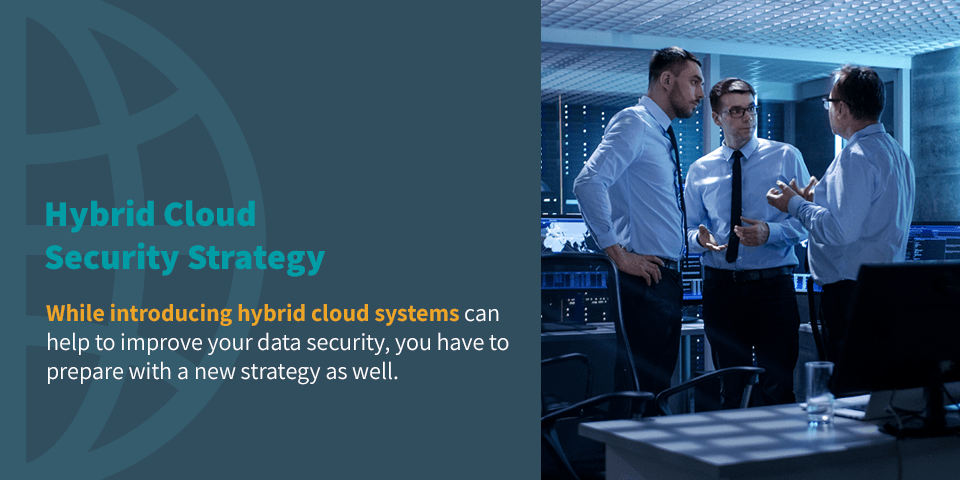
Hybrid Cloud Security Strategy
While introducing hybrid cloud systems can help to improve your data security, you have to prepare with a new strategy as well. It can help reduce vulnerabilities and risks, but it also adds new complexities to your management processes as it moves your data to multiple platforms. Adjusting to the new system may be easy for some and more difficult for others. However, by developing a plan for security, you can make sure you and your employees are on the same page as far as security protocols go.
Some of the details you should consider in adapting to a new hybrid cloud security strategy include:
- Shared responsibility: When it comes to ensuring you have secure data and applications, your business is fundamentally responsible. But it can be detrimental to work with a cloud vendor who views your company as such. Look for a vendor that sees your data security as a mutual responsibility. If a provider incorporates security measures into their platforms, offers assistance and resources to ease the management workload and helps your company instill best practices, they are a worthwhile partner.
- Cloud compatible tools: When you’re choosing the tools you’re going to work with, make sure they integrate well with your cloud systems. If they don’t, they could cause more of a headache than they’re worth. Additionally, if you can cut down on the risk of failure due to human error, it will help your management team with workflow and simplify development efforts.
- Communications and ownership: When it comes to implementing the cloud, your management systems should help your team monitor and work across multiple platforms. Consistent communications and a clear picture of who is responsible for assets and data are essential to your internal security teams. By ensuring visibility, you’ll have the confidence of knowing nothing is overlooked.
- Access management: One of the most significant security concerns is making sure no one has access to more information than they need. Implementing identity and access management (IAM) frameworks will allow you and your team to monitor who can see what. Enforce a policy of least-privileged access, where those who do have entry can only get to the resources they need to complete their jobs.
With a strong management system and a few strategic policies in place, you can keep your hybrid cloud infrastructure running smoothly. It will help to know that your teams and providers are all on board with the same plans and that if anything does go awry, you are ready to catch it and provide a quick solution.
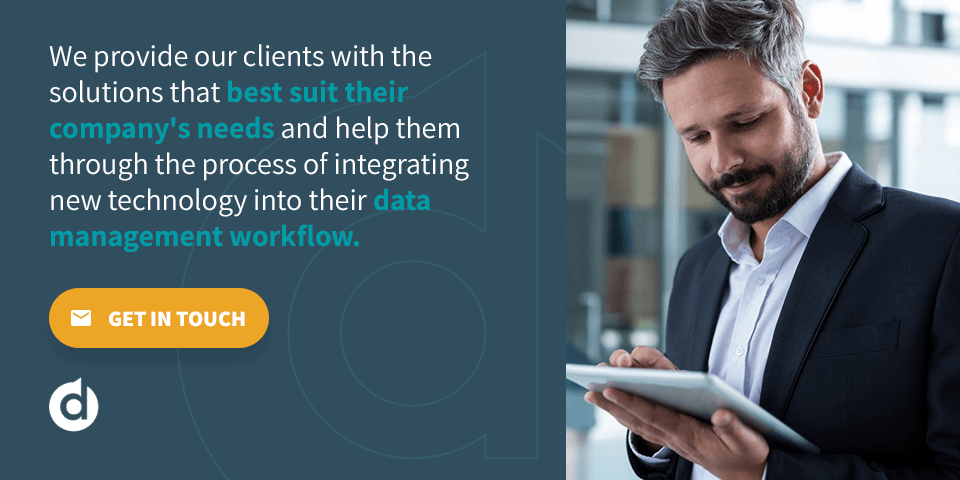
Hybrid Cloud Services From DataSpan
When you need a reliable provider for your cloud integration, DataSpan has you covered. Since 1974, our team has been helping companies optimize their data centers, and we have grown to become one of the largest data storage products and services companies in the country. We provide our clients with the solutions that best suit their company’s needs and help them through the process of integrating new technology into their data management workflow.
When you partner with DataSpan, you’ll have access to the latest technology available, as well as our team of professional technicians. Get started implementing a hybrid cloud system for your company. For more information, contact us or find your local representative.







